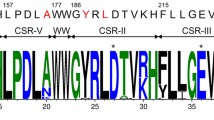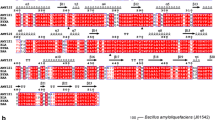Abstract
Successful industrial use of amylases requires that they are sufficiently stable and active at application conditions, e.g., at high temperature in starch-liquefaction process. In the present study, site-directed mutagenesis was used to enhance the thermal stability and calcium independency of a mesophilic α-amylase from Bacillus megaterium WHO. Mutations (A53S and H58I) were designed at the calcium-binding site based on the sequence alignment. Kinetic and thermostability parameters of the mutants were analyzed and compared with that of the wild type. In the presence of calcium, the affinity of the enzymes (wild type and mutants) toward starch was increased. In comparison to the wild type, calcium ion had more effect on the catalytic efficiency, k cat/K m, and half-life (at 60 °C) of A53S mutant. In A53S, the dependence of half-life on calcium concentration showed that the enhanced calcium binding is likely to be responsible for the increased stability. In contrast, calcium-independent mutant (H58I) possessed high thermostability. In addition, thermodynamic parameters of amylolytic reaction exhibited an increase in the activation energy and the entropy of the system. Kinetics of irreversible thermal inactivation suggests that the activation energy increased by 1.4-fold in the most stable variant.








Similar content being viewed by others
References
Nielsen, J. E., & Borchert, T. V. (2000). Biochimica et Biophysica Acta, 1543, 253–274.
Tanaka, A., & Hoshino, E. (2002). Biochemical Journal, 364, 635–639.
Haki, G. D., & Rakshit, S. K. (2003). Bioresource Technol, 89, 17–34.
Tripathi, P., Hofmann, H., Kayastha, A. M., & Ulbrich-Hofmann, R. (2008). Biophysical Chemistry, 137, 95–99.
Vallee, B. L., Stein, E. A., Sumerwell, W. N., & Fischer, E. H. (1959). Journal of Biological Chemistry, 234, 2901–2905.
Imanaka, T., Shibazaki, M., & Takagi, M. (1986). Nature, 324, 695–697.
IIInase, A. (1999). EJB, 2, 7–15.
Yazdani, M., Naderi-Manesh, H., Khajeh, K., Soudi, M. R., Asghari, S. M., & Sharifzadeh, M. (2009). Journal of Basic Microbiology, 49, 119–127.
Tan, T. C., Mijts, B. N., Swaminathana, K., Patel, B. K. C., & Divne, C. (2008). Journal of Molecular Biology, 378, 850–868.
Tan, T. C., Yien, Y. Y., Patel, B. K. C., Mijts, B. N., & Swaminathana, K. (2003). Acta Crystal, D59, 2257–2258.
Sivakumar, N., Li, N., Tang, J. W., Patel, B. K. C., & Swaminathan, K. (2006). FEBS Letters, 580, 2646–2652.
Sambrook, J., & Russell, D. W. (2001). Molecular cloning: a laboratory manual (3rd ed.). New York: Cold Spring Harbor.
Owen, R. J., & Borman, P. (1987). Nuclear Acids Research, 15, 3631–3632.
Fisher, C. L., & Pei, G. K. (1997). BioTechniques, 23, 570–574.
Bradford, M. M. (1976). Analytical Biochemistry, 72, 248–254.
Laemmli, U. K. (1970). Nature, 227, 680–685.
Miller, G. L. (1959). Analytical Chemistry, 31, 426–428.
Arrhenius, S. (1889). Zeitschrift fuÉr physikalische Chemie, 4, 226–248.
Fu, L. L., Xu, Z. R., Li, W. F., Shuai, J. B., Lu, P., & Hu, C. X. (2007). Biotechnology Advances, 25, 1–12.
Dong, G., Vieille, C., & Zeikus, J. G. (1997). Applied and Environmental Microbiology, 63, 3577–3584.
Janecek, S. (2002). Biologia, 11(57/Suppl), 29–41.
Danson, M. J., Hough, D. W., Russel, R. J., Tayler, G. L., & Pearl, L. (1996). Protein Engineering, 9, 629–630.
Lin, L. L., Huang, C. C., & Lo, H. F. (2008). Process Biochemistry, 43, 559–565.
D'Amico, S., Gerday, C., & Feller, G. (2003). Journal of Molecular Biology, 332, 981–988.
Violet, M., & Meunier, J. C. (1989). Biochemical Journal, 263, 665–670.
Hassan Sajedi, R., Naderi-Manesh, H., Khajeh, K., Ahmadvand, R., Ranjbar, B., Asoodeh, A., et al. (2005). Enzyme and Microbial Technology, 36, 666–671.
Takasaki, Y. (1982). Agricultural and Biological Chemistry, 46, 1539–1547.
Kanno, M. (1986). Agricultural and Biological Chemistry, 50, 23–31.
Tsvetkov, V. T., & Emanuilova, E. I. (1989). Applied Microbiology and Biotechnology, 31, 246–248.
Hagihara, H., Igarashi, K., Hayashi, Y., Kitayama, K., Endo, K., Ozawa, T., et al. (2002). J Appl Glycosci, 49, 281–289.
Acknowledgement
The authors express their gratitude to the research council of Tarbiat Modares University for the financial support during the course of this project.
Author information
Authors and Affiliations
Corresponding author
Rights and permissions
About this article
Cite this article
Ghollasi, M., Khajeh, K., Naderi-Manesh, H. et al. Engineering of a Bacillus α-Amylase with Improved Thermostability and Calcium Independency. Appl Biochem Biotechnol 162, 444–459 (2010). https://doi.org/10.1007/s12010-009-8879-2
Received:
Accepted:
Published:
Issue Date:
DOI: https://doi.org/10.1007/s12010-009-8879-2




